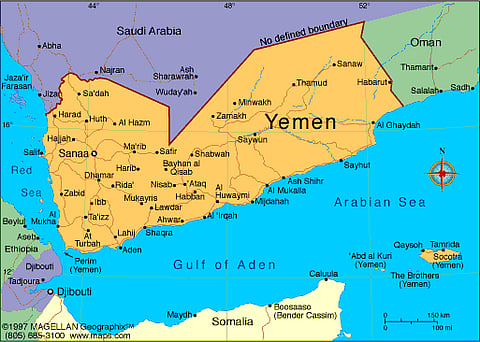
- Home
- न्यूजग्राम
- NewsGram USA
- India
- World
- Politics
- Entertainment
- Culture
- Lifestyle
- Economy
- Sports
- Sp. Coverage
- Misc.
- NewsGram Exclusive
- Jobs / Internships

By Gaurav Sharma
What was once the Happy Arabia (Arabia Felix) has now transformed into a ghastly war-zone. Caught in the crossfire of power grab, the Middle Eastern nation of Yemen has been ravaged by a series of humanitarian crisis since the past decade.
Soaring unemployment, declining oil prices and water resources, apart from being the favorite hunting ground for al-Qaeda's most vicious branch (AQAP) have metamorphosed Yemen into the poorest nation in the Middle East.
At the same time, a raging battle from multitudinal sides has wreaked havoc in Yemen, tearing it further apart into ever smaller factions.
What is the war all about?
The conflagration of violence is a fight between the supporters of the current leadership of President Abdrabbuh Mansour Hadi and loyalists of the Zaidi Shia rebels, popularly known as the Houthis.
Loyalties have been sharply divided between the two forces. While the Sunni south region (particularly the tribesmen and militias) pledges allegiance to President Hadi, other units including ex-President Ali Abdullah Saleh, a popular but polarizing figure in Yemen, vouch for the Houthis.
The battle is not just two-sided. Al-Qaeda in the Arabian Peninsula (AQAP), a deadly faction of the global terror group, assumes command in the south and the south-eastern regions of Yemen. It has launched several attacks including on several mosques apart from planning and undertaking the Charlie Hebdo shootings in France.
To make the grim situation more complex, Islamic State, the most barbarous of all al-Qaeda offshoots, has launched its own string of attacks against Shia Houthis. The terror outfit has warned that these attacks "are only a part of the impending flood", highlighting the ethereal state of affairs in the country.
What about the rest of the Middle East?
The current restiveness in Yemen has implications for the rest of the middle east. Saudi Arabia, the largest Arab nation in Western Asia, has already launched widespread air strikes against the Houthis in view of the precarious situation.
In this regard, the conflict assumes a sectarian character. Saudi Arabia is a Sunni Muslim nation whereas the Houthis are predominately Shias. After the Houthis swept the capital city of Sanaa in 2014, Saudi Arabia, other Gulf states, and African nations including Jordan, Morocco, Sudan, and Egypt became wary of the potential rise of Shia Islam in the Middle East and elsewhere.
Moreover, in light of the boost received by Iran through the nuclear deal, the Gulf states suspect the hand of Iran behind the sudden rise of Houthis. (Iran is a Shia dominated country)
The reason for declaring war on the Houthi rebels in Yemen follows from the contention that Iran is looking to expand its footprint in the Middle East. According to the Arab Gulf Cooperation Council (GCC), up to 5,000 Iranian and Iraqi trainers were present in Yemen, before Saudi Arabia launched its offensive.
Are there other reasons for the conflict?
The sectarian hues and ideological differences notwithstanding, strategic considerations assume paramount importance in the battle for Yemen. The Bab al-Mandab strait, a channel between Yemen in the Arabian peninsula and Djibouti in the Horn of Africa, provides a crucial link between the Red Sea and the Gulf of Aden (a passage through which bulk of the world's oil shipments pass).
Another unlikely factor which led to the eruption of the political upheaval in Yemen is the dire ecological condition of the region. The groundwater situation has never been handled appropriately by the successive governments.
From 30 meters below surface in 1970's to more than 1000 meters below surface in 2012, the groundwater condition has only deteriorated. There are reports doing the rounds that Yemen might claim the distinction for being the first country to run out of water. Lack of sufficient water means deficiency of food crops, thereby aggravating the situation further.
In the midst of the arid ecological future awaiting them, the Yemeni people had no option but to flee the country or to fight amongst each other small battles which sometimes, if not more often than not, assume epic proportions.
How did Yemen end up where it is today?
Apart from being a possible location for the Biblical kingdom of Sheba, Yemen acted as a conduit (spice route) to the Middle East for African, Asian nations.
The modern state of Yemen propped-up in 1990, after the unification of the communist south Yemen and the traditional northern region. In 1994, a civil war ensued between the south and the north quelling the southern separatists.
During the transformation phase, Yemen became the hotspot for Islamic militants even as the western powers launched a clampdown on al-Qaeda activities in Pakistan and Afghanistan.
Houthi rebels used the fragile governance landscape to their advantage and reemerged as the harbingers of revolt.
